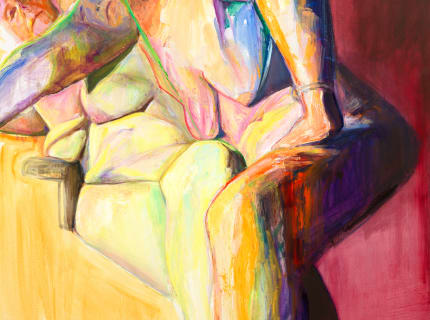Joan Semmel has never displayed any embarrassment about portraying her own body, confronting without compromise all the subtle modifications wrought by age. For five decades, her painting has focused principally on the depiction of her nakedness, and from the beginning she has taken control of her subjectivity—her female sexuality, her sense of intimacy—with the same direct ethics of desire utilized by Ida Applebroog or Hannah Wilke. In self-portraits and intimate scenes from the early 1970’s, bodies are observed from her point of view at disorienting, dramatic angles without any sentimentality, reclaiming an essential purity of womanhood beyond the fetishizing patriarchal gaze. These formidable images by an articulate and independent woman underline the politics and concerns of a second-wave feminist who transforms our way of looking at women and how they see themselves. Rejecting the classical and idealized concept of the female body, the artist shows us her flesh, genitals, and abundant breasts—she is not interested in the face but in skin, minus any frills—and returns us to our shared humanity. Semmel avoids the definition of backgrounds or of objects; the colors over which her bodies are suspended are made up of saturated reds, velvety purples, vivid greens, and shrill oranges. Exploring the sensuality in undescribed interiors, she causes the psychological power of the human figure to explode, and she inscribes every gesture, every posture, into an everlasting present.
“Against the Wall,” the artist’s exhibition here, features a group of paintings, made between 2021 and 2023, that present loose renderings of the artist positioned against a white background. We see her leaning upon a vertical surface, in need of support, or kneeling on the ground, tired, her face obscured by gray hair or her own hand. Now that she is over ninety years old, Semmel acknowledges her own finitude, depicting herself in spaces that appear confined and simultaneously infinite. Thus, she forces us to confront the inevitability of death and, within these nebulous spaces, what may lie beyond. Her lonely figure calls to mind Edvard Munch’s in his late painting Self-Portrait. Between the Clock and the Bed., 1940–43, in which the artist stands at attention in a domestic setting full of pattern and color. He faces the viewer as a somber and solitary figure who, like Semmel, is grimly aware that time is running out.
The depiction of her own shadow in these works is quite overt. Semmel appears to be consciously embracing the darkness and fear that come with death. Recognizing this, in Jungian terms, is the only way for one to become whole. Semmel expresses this process of integration by juxtaposing the luminous hues of her skin—pink, yellow, orange—with the bruise-like grays, greens, reds, and purples comprising her umbral other. In Morphing, 2023, the shadow on the wall does not correspond to the soft shapes of the artist’s body; it becomes more angular, with a geometric silhouette that makes one think of a female paleolithic statue or ancient archetypes of primeval goddesses. Offering multiple views of her body coming forward or retreating into the background, the artist suggests a kind of movement that reads as the passage of time. Also, the figure’s doubling alludes to the separation of the ethereal body from the physical one—a ghosting, an aura.
Semmel addresses her own mortality with sensitivity and fearlessness. These works are as delicate as they are demanding, and rage against the dying of the light with a profound tenderness.

